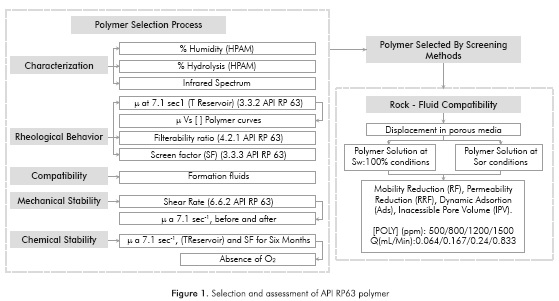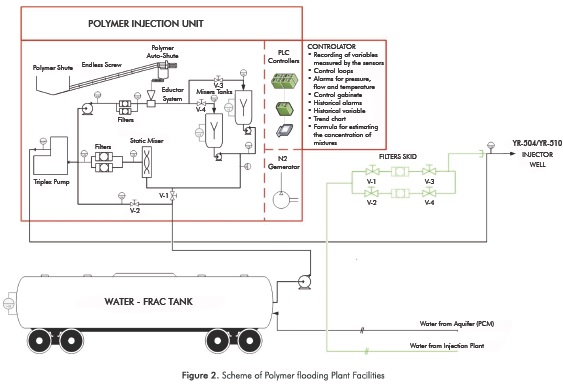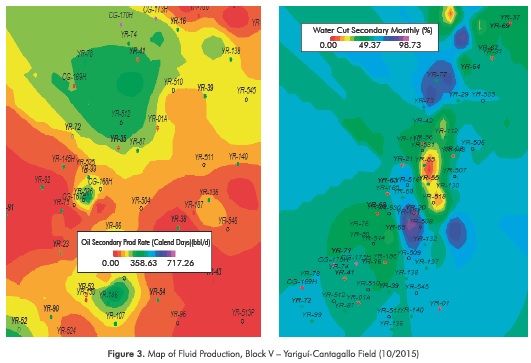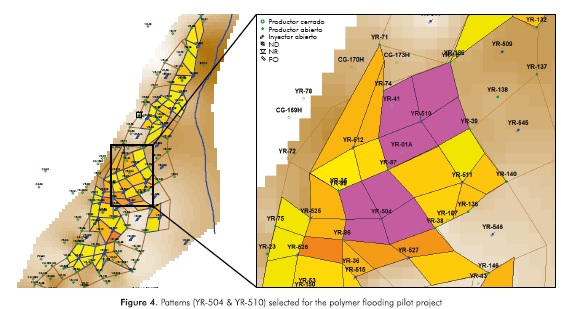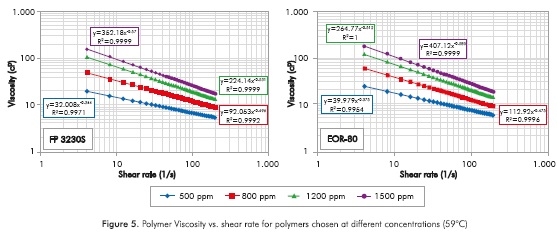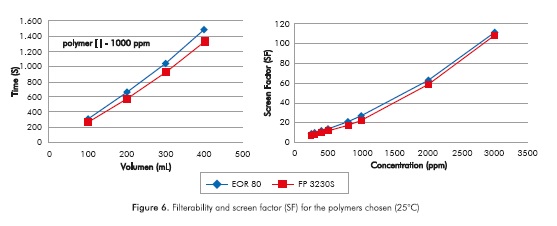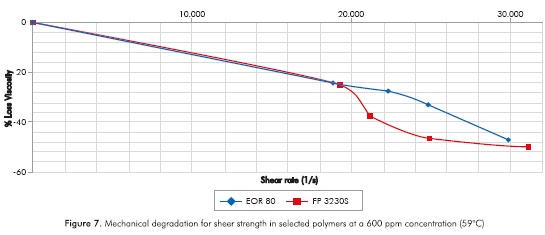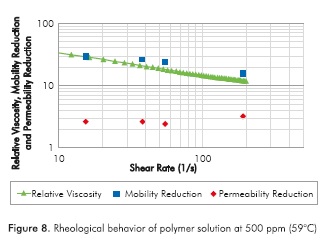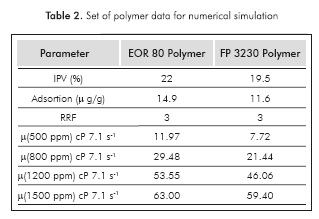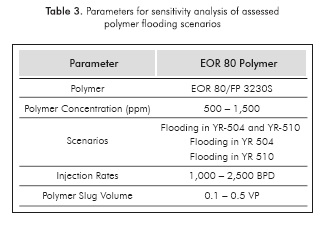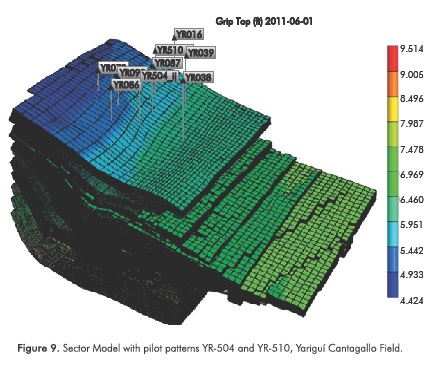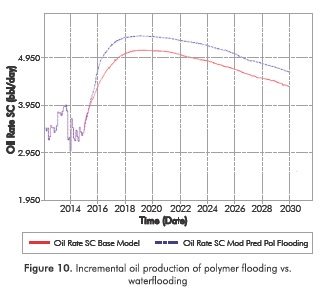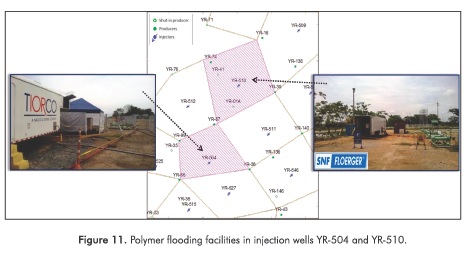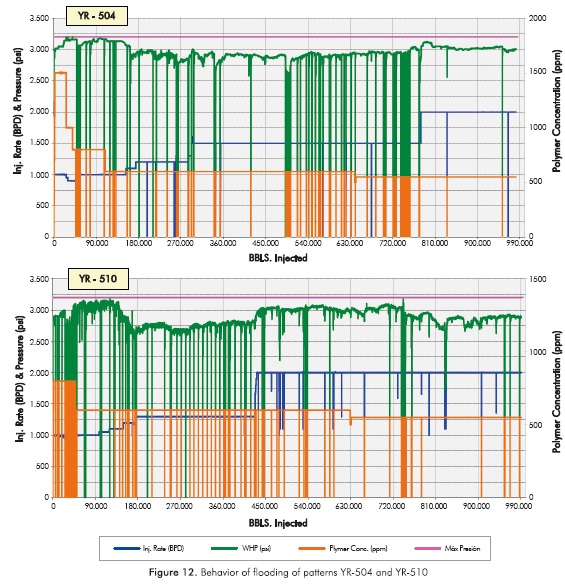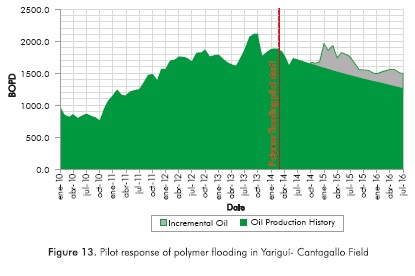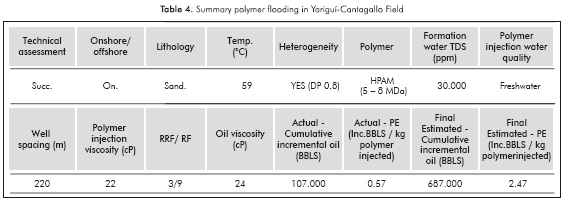Services on Demand
Journal
Article
Indicators
-
 Cited by SciELO
Cited by SciELO -
 Access statistics
Access statistics
Related links
-
 Cited by Google
Cited by Google -
 Similars in
SciELO
Similars in
SciELO -
 Similars in Google
Similars in Google
Share
CT&F - Ciencia, Tecnología y Futuro
Print version ISSN 0122-5383
C.T.F Cienc. Tecnol. Futuro vol.6 no.3 Bucaramanga Jan./June 2016
POLYMER FLOODING TO IMPROVE VOLUMETRIC SWEEP EFFICIENCY IN WATERFLOODING PROCESSES
INYECCIÓN DE POLÍMERO PARA EL MEJORAMIENTO DE LA EFICIENCIA DE BARRIDO VOLUMÉTRICO EN PROCESOS DE INYECCIÓN DE AGUA
INJEÇÃO DE POLÍMERO PARA O MELHORAMENTO DA EFICIÊNCIA DE BARRIDO VOLUMÉTRICO EM PROCESSOS DE INJEÇÃO DE AGUA
Rubén-Hernán Castro-Garcia1*, Gustavo-Adolfo Maya-Toro1, Robinson Jimenez-Diaz1, Henderson-Ivan Quintero-Perez2, Venus-Minerva Díaz-Guardia2, Kelly-Margarita Colmenares-Vargas2, Jorge-Mario Palma-Bustamante1, Claudia-Lorena Delgadillo-Aya1 and Romel-Antonio Pérez-Romero1
1 Ecopetrol S.A. - Centro de Innovación y Tecnología (ICP), A.A. 4185 Bucaramanga, Santander, Colombia
2 Universidad Industrial de Santander, Bucaramanga, Santander, Colombia
e-mail: rubenHe.castro@ecopetrol.com.co
How to cite: Castro-García, R. H., Maya-Toro, G. A., Jimenez-Diaz, R. Quintero-Perez, H. I., Díaz-Guardia, V. M., Colmenares-Vargas, K. M., Palma-Bustamante, J. M., Delgadillo-Aya, C. L. & Pérez-Romero , R. A. (2016). Polymer flooding to improve volumetric sweep efficiency in waterflooding processes. CT&F - Ciencia, Tecnología y Futuro, 6(3), 71 -90.
* To whom correspondence should be addressed
(Received: Sep. 16, 2015; Accepted: May 10, 2016)
ABSTRACT
Polymer flooding is a commercial Enhanced Oil Recovery (EOR) process that belongs to the chemical EOR methods. Its principal objective is to improve reservoir sweep efficiency in mature and recent waterfloods.
This paper describes a methodology, developed at the Instituto Colombiano del Petróleo, for the theoretical evaluation, project design (screening, geological and engineering analysis, experimental evaluation, numerical simulation and financial analysis), pilot implementation and surveillance of the injection process.
The first polymer flooding pilot implemented in Colombia by Ecopetrol is described here as an example of the methodology developed. Results of this project show an increase in oil production rates and, a decrease in water cuts increasing the oil recovery factor of patterns YR-504 and YR-510 of Yarigui- Cantagallo Field.
Over two million barrels of polymer solution have been injected in the pilot during the first two continuous years of operation. This enables the assimilation of lessons learned and best practices for continual improvement in the operation of such processes. Based on the pilot success, the feasibility of expanding this EOR method in this and other Colombian fields is being evaluated.
Keywords: Polymer flooding, Enhanced oil recovery (EOR), Chemical injection, waterflooding, hydrolyzed polyacrylamide (HPAM), Experimental feasibility, Coreflooding test, Numerical simulation. Polymer flooding facilities, Yarigui- Cantagallo Field.
RESUMEN
La inyección de polímero es un proceso comercial de recobro mejorado perteneciente a la familia del recobro químico. Su objetivo principal es mejorar la eficiencia de barrido volumétrica de procesos de inyección de agua tanto maduros como nuevos.
El artículo describe una metodología, desarrollada en el Instituto Colombiano del Petróleo (ICP), para la evaluación teórica, diseño (screening, análisis geológico y de ingeniería, estudio de laboratorio, simulación numérica de yacimientos y análisis financiero), implementación en campo a escala piloto y monitoreo del proceso de inyección.
Como caso de aplicación de la metodología se presenta el primer piloto de inyección de polímero implementado en Colombia por Ecopetrol. Los resultados de este proyecto muestran aumento en la producción de petróleo, disminución de los porcentajes de producción de agua e incremento del factor de recobro en el sector de los patrones YR-504 y YR-51 0 del Campo Yariguí- Cantagallo.
En el piloto se han inyectado más de dos millones de barriles de solución polimérica en dos años continuos de operación. Esto permitió la asimilación de las lecciones aprendidas y de buenas prácticas para la mejora continua en la operación de este tipo de procesos. Con base en los buenos resultados del piloto, se evalúa la factibilidad de expandir el método de recobro mejorado en éste y otros campos de Colombia.
Palabras clave: Inyección de polímero. Recobro mejorado de petróleo. Recobro químico, Inyección de químicos, Inyección de agua, Poliacrilamida parcialmente hidrolizada, Factibilidad experimental, Simulación numérica, Facilidades de inyección de polímero, Campo Yariguí- Cantagallo.
RESUMO
Ainjeção de polímero é um processo comercial de recuperação que pertence à família da recuperação química. Seu objetivo principal é melhorara eficiência de barrido volumétrico de processos de injeção de água tanto madurecidos quanto novos.
O artigo descreve uma metodologia, desenvolvida no Instituto Colombiano do Petróleo (ICP), para a avaliação teórica, concepção do projeto [screening, análises geológico e de engenharia, avaliação experimental, simulação numérica e análise financeira), implementação em campo a escala piloto e monitoramento do processo de injeção.
Como caso de aplicação da metodologia apresentamos o primeiro piloto de injeção de polímero implementado na Colômbia pela Ecopetrol. Os resultados deste projeto mostram um aumento na produção de petróleo, diminuição das porcentagens de produção de água e incremento do fator de recuperação no setor dos padrões YR-504 e YR-510 do Campo Yariguí- Cantagallo.
No piloto já foram injetados mais de dois milhões de barris de solução polimérica em dois anos contínuos de operação. Isso possibilitou a assimilação das lições aprendidas e de boas práticas para a melhora continua na operação deste tipo de processos. Com base nos ótimos resultados do piloto, é possível avaliar a viabilidade de expandir o método de recuperação melhorado em esse e outros campos da Colômbia.
Palavras-chave: Injeção de polímero, Recuperação melhorada de petróleo, Recuperação química, Injeção de químicos, Injeção de água, Poliacrilamida parcialmente hidrolisada, Viabilidade experimental, Simulação numérica, Facilidades de injeção de polímero, Campo Yariguí- Cantagallo.
1. INTRODUCTION
Waterflooding is one of the most widely known and implemented oil recovery processes worldwide. Nevertheless, application of this secondary process involves limitations for sweep efficiency. Therefore, it is necessary to implement enhanced oil recovery (EOR) methods with the purpose of increasing both volumetric and displacement efficiencies and increasing, thus, the recovery factor, even at early stages of the waterflooding process (Alvarado & Manrique, 2010).
Use of polymer solutions to improve volumetric sweep efficiency based on a reduction of mobility ratios in waterflooding processes has become a standardized practice in the operation of different oil fields. Mungan, Smith and Thompson (1966) conclude that mobility of polymer solutions is affected by several factors such as the polymer concentration, type and size of molecule, water salinity, pH, capillary properties of the rock and crude oil type. The polymer flooding process is more effective in cases of heterogeneous fields containing moderate-viscosity crude oil. However, Mogollon and Lokhandwala (2013) provided evidences of good results in high-viscosity crude oil reservoirs.
The average recovery factor in Colombia is approximately 19%, and about 90% of the oil fields of the country are still producing at their primary stage. About 88% of production comes from primary recovery, 11% of secondary recovery and less than 1% of production come from enhanced oil recovery (Castro et al, 2010). Different enhanced oil recovery pilots have been implemented as alternatives to increase oil production and maximize final recovery in Colombian fields.
This paper discusses the strategy, protocols and methodology used to design, implement and monitoring a polymer flooding project. It presents as an application case the stages of screening (Sandoval et al, 2010; Trujillo et al, 2010), area selection, experimental feasibility, numerical simulation, infrastructure, financial analysis, automation, execution and online monitoring of the first polymer flooding pilot project executed in Colombia by Ecopetrol.
In the experimental study, the selection of polymers was based on the following parameters: compatibility and solubility with the formation water, viscosity of the polymer as a function of concentration and shear stress, viscoelasticity (screen factor), filterability and Theological behavior studies. Even though the test protocols used were mainly based on the API RP63 standard (1990), other methods for selection of products (Levitt & Pope, 2008; Seright, Seheult & Talashek, 2008; Sorbie, 1991) were also considered. The technical and experimental evaluation process identified two companies to supply and inject the selected polymer.
Execution of the pilot project started in March 2014. Strategically, it has two flooding patterns operated by different companies; the injection facilities (single well type) used have allowed the displacement of more than two million barrels of polymer solution to the reservoir. Some results of this project are a decrease in water production and an increase in oil production and final expected recovery factor.
Some operating indicators such as water quality, power supply and non-productive times have been improved to obtain a better performance and control of the process. During execution of this project, no accidents or environmental incidents have occurred.
2. THEORY AND CALCULATIONS
The use of polymers in enhanced oil recovery processes dates back to the beginning of the 60s. Ever since, a high number of field tests have been reported in literature with a higher number of successful cases around the world since the 80s, especially in China, where oil production is significant thanks to CEOR processes (Weiss & Baldwin, 1985; Putz, Lecourtier & Bruckert, 1988; Putz & Rivenq, 1992; Delamaide, Corlay & Wang, 1994; Han, 1999; Du & Guan, 2004; Chang et al, 2006; Li et al, 2009; Wang et al, 2009; Zhang et al, 2016) and recently in projects developed in Canada, Oman, Surinam, Colombia, among others (Manrique et al, 2010; Buciak, Fondevila & Del Pozo 2013; Standnes & Skjevrak, 2014; Maya et al, 2015b).
Two types of polymers have been used for field applications: polysaccharides and polyacrylamides, being the partially hydrolyzed polyacrylamide (HPAM) the most widely used polymer in EOR applications (Manrique, Muci & Gurfinkel, 2007). In fresh water, due to charge repulsion of the carboxylic group, the flexible chains of the HPAM structure stretch raising the viscosity of the solution. In contrast, in high salinity water charges are neutralized or covered and the flexible chains of the HPAM structure are compressed resulting in solutions with lower viscosity (Sheng, 2011). Levitt and Pope (2008) reported that polymers of hydrolyzed acrylamide should not precipitate in reservoirs with a temperature until 100 °C and water with calcium content below 200 ppm. For high calcium concentrations and high temperatures copolymers of acrylamide (AMPS) improved with sodium metaborate and sodium carbonate, which developed more stability in their viscosity, have been evaluated.
According to Luoet al. (2001), at high shear rate, the structures organized in polymer networks are altered and, thus, viscosity is significantly reduced. Nonetheless, when the applied shear rate was reduced, the polymer structural network was restored and viscosity was increased again. Viscosity reversibility is highly beneficial in EOR field applications since injectivity reduction is normally a major concern. Far from the wellbore, flow speed is reduced and viscosity is restored (Sheng, 2011).
Some researchers concluded that polymer flooding may reduce relative permeability of the aqueous phase (Barreau et al, 1999; Zheng et al., 2000; Grattoni et al., 2004). On their part, Huh and Pope (2008) observed that residual oil saturation is lower after a polymer flooding process than after an analogous waterflooding process.
Interaction of the aforementioned parameters makes the flow of polymer solutions in porous media a very complex process. Additionally, uncertainties associated to reservoir characterization make the design and implementation of a robust polymer flooding project a challenge. A poor design and implementation of a polymer flooding project may even cause a reduction in oil production; thus, authors as Yuan (2009) highlight the importance of a representative numerical simulation before the polymer injection in the field as an essential step to be successful in the design and implementation.
3. METHODOLOGY
Implementation of recovery technologies is essential to increase the recovery factor in Colombian oil fields. In order to reach the production and reserve goals of the Company, Ecopetrol started an aggressive plan for implementation of waterflooding combined with the optimization in progress of such fields using conformance technologies and assessment of different EOR technologies as the injection of colloidal dispersion gels, polymers and surfactants (Castro et al., 2010, Castro-García et al., 2013a, Castro et al., 2013b; Castro et al, 2014; Maya et al, 2012, Maya et al, 2014; Maya et al, 2015a; Maya et al, 2015b León et al, 2015).
Accordingly, Has Instituto Colombiano del Petróleo (Colombian Petroleum Institute) of Ecopetrol developed an integrated methodology from the preliminary assessment to the field implementation at pilot scale including monitoring strategies of the polymer flooding process with the purpose of providing guidelines for the design, execution and optimization of this enhanced oil recovery process. This section summarizes the methodological analysis of the main stages executed in the pilot project of polymer flooding in Yarigui-Cantagallo Field, which was developed and implemented following the methodology created (Maya et al, 2015b). According to the technical screening, the field characteristics are appropriate to implement polymer and surfactant-polymer flooding technologies as enhanced recovery methods.
Area Selection
As initial input, a detailed data gathering and analysis is required to assess the static and dynamic information of the reservoir. The review of every wellbore configuration status and the injection/production history also represents a critical step to identify, rank and select potential areas for polymer flooding implementation. Basically, an area must have enough recoverable oil, hydraulic connectivity between injection and production wells, active flooding patterns and, preferably, the sector must be confined to be selected (Castro et al, 2013a).
Experimental Evaluation
The experimental evaluation is developed in accordance with the recommended practices for assessment of polymers used in enhanced oil recovery operations (API RP63). Basically, the behavior of polymers viscosity at different concentrations and conditions is evaluated; filterability and rheological studies (mechanical degradation tests) are conducted considering the wellbore conditions and the surface facilities. Finally, the thermal and chemical degradation are evaluated at reservoir conditions using the preparation water (field and synthetic) of the polymer solution (Figure 1).
The first phase of experimental evaluation is the polymer characterization, which is made through a spectroscopy analysis. The polymer samples are analyzed in conformity with the procedure of the Technical Testing Instructions (ITE) CLX-LQP-I-024 of ICP, using an infrared spectrophotometer (IR) with attenuated total reflectance cell. This technique allows to obtain the IR spectrum directly from solid samples. This spectrum is unique for each component and the band frequencies obtained in the analysis are specifically associated with the functional groups included in the analyzed sample.
Thereafter, the humidity and hydrolysis percentage of the polymer samples are determined in accordance with the ICP procedures ITE CLX-LQP-I-038 and ITE CLX-LQP-I-039 respectively. The humidity test is necessary to determine the free water content in the sample (this result must be considered when calculating the amount of polymer used to prepare the polymer solutions). In turn, the hydrolysis percentage is used to determine chemical stability of the polymer (this result can show the approximated proportion of the monomer of acrylic acid in the HPAM, which is still hydrolysable). This test is made by Potentiometrie titration with hydrochloric acid and sodium hydroxide in solutions.
The next step is to determine the viscosity of the polymer solutions. Generally, viscosity measurements are made using a Brookfteld DV2TLV viscometer with UL adapter (Digital viscometer 2T series adapted for low viscosities). Several solutions are prepared at different concentrations and viscosity of each solution is determined in order to identify the optimal concentration. Additionally, the screen factor test is conducted for different polymer solutions previously nitrated to know their viscoelastic behavior.
The filterability test is important to verify the step of the polymer solution through a representative system. The procedure is made passing the polymer solution through a mesh of 5 um and 44 mm of diameter applying a pressure of 22 psi in the system and recording the time of passing the solution by intervals of 100 mL volume. If there are no evidences of clogging of the system, the filterability radius must not be higher than 1, but considering the process tolerance and uncertainty in measurements, values of up to 1.2 are accepted. A variation of this technique, which consists in injecting the polymer solution at a constant flow through a membrane, generally of 5 um, and monitoring the pressure differential as it is injected, is added to the methodology (Seright et al., 2008).
The polymer mechanical degradation test is conducted in conformity with the ICP procedure ITE CLX-LQP-I-037, with the purpose of simulating the shear rate experimented by the polymer solution through the injection facilities, the wellbore configuration and the perforated interval. For this test, the polymer solution is injected through a capillary tube at a specific flow rate which shall cause similar shear rate to the expected in the process. The goal is to identify the polymers that present lower viscosity losses after applying shear rate.
Finally, the thermal and chemical degradation tests of polymer solutions are conducted in accordance with the procedure ITE CLX-LQP-I-036. This is a long test that monitors the viscosity of the polymer solution when it is exposed for long periods to reservoir conditions, using the composition of the injection water, including water treatment chemicals (i.e. biocides, oxygen scavengers). Polymer solutions viscosity is always compared to the initial reference viscosity.
In a second experimental phase, linear displacement (coreflooding) tests are performed at reservoir conditions using reservoir cores. This corefloods are run using only the polymers that met the criteria of the experimental fluid-fluid assessment. Determination of rheological viscosity curves based on the shear rate is made following the ITE CLT-FIR-I-009 procedure, using an Anton Paar compact modular rheometer. Injection of polymer solutions prepared in synthetic water at optimal concentration and at constant flow rate is made in presence of crude oil to measure the dynamic adsorption and the inaccessible porous volume (IPV) in the rock following the procedure established in the API RP63 standard and methods referred in the literature (Hirasaki & Pope, 1974; Zaitoun & Kohler, 1988; Zhang & Seright, 2013). Immediately thereafter, injection of the polymer solution starts at different concentrations and flow rates to build mobility reduction curves (resistance factor or RF) and residual resistance factor (RRF) according to the GTN-I- 054 and GTN-I-055 de ICP procedure of ICP. The final goal of the methodology used in these displacement tests is to obtain a group of specific and reliable results to be used as input data in the numerical simulation of the pilot project and the reservoir to reasonably predict the global effect of polymer flooding.
Numerical Simulation and Process Design
The numerical simulation is an effective and useful tool that allows representing approximately the behavior of phenomena and processes that may occur in the reservoir, allowing the engineer to make the history matching and forecasts of the behavior of primary, secondary and enhanced recovery projects. Representativeness of these results depends largely on the geological model of reservoir and the quality of the information included in the simulator. For this reason, it is convenient to make an uncertainties evaluation through a detailed sensitivity analysis in order to obtain the most adequate forecast.
Accordingly, numerical simulation supports the design of the polymer flooding process since it helps to define the percentage of porous volume to be injected, operating conditions of the process, and estimated capacity of the surface facilities and different injection scenarios that may be assessed technically and economically.
Numerical reservoir simulation is generally developed in commercial software (i.e. CMG STARS®). The behavior of the polymer solution is typically represented by four parameters. The first one is the dynamic adsorption, retention and/or trapping and its propagation in the reservoir rock. The second one corresponds to the inaccessible pore volume (IPV) that is important to model the porous fraction of the rock in which the polymer solution would not penetrate. The third one corresponds to the viscosity of the polymer solution and the sheer rates which are directly related to mobility reduction (RF) and the last one is the reduction of permeability in the reservoir after the polymer flooding process (RRF).
Injection Facilities
The polymer flooding facility is generally designed as a functional unit in a closed cycle of blending, dilution, pumping and final injection in the well with the goal of avoiding undesired losses and leaks in the process, as well as guaranteeing the quality and effectiveness of such process.
Surface facilities include water storage, power system and injection unit equipped with a solid polymer dosing system, blending and tanks for maturing, hydration and activation of the polymer, positive displacement pumps for injection and a nitrogen flow system in the entire unit to displace the oxygen avoiding polymer degradation. Figure 2 shows and scheme of the polymer flooding facilities used to inject in wells YR-504 and YR-510
Process Execution and Monitoring
Prior to the enhanced recovery project, it is essential to make civil, mechanical and electric adjustments to install the surface facilities. Governmental, environmental, property, social and, in some cases, archeological authorizations must be obtained. Likewise, it is necessary to assure the necessary resources for the polymer solution injection. The most important resources are: preparation water (aquifer and/or production), power requirements of the injection unit (centralized or modular), chemicals storage and polymer flooding pipes.
Additionally, it is important to have competent staff to operate the injection plant, monitoring the operation and follow up the process from the point of view of operation and reservoir engineering. In general, the injection rate and, in some cases, the polymer concentrations are the most common variables to be adjusted throughout the execution. It is necessary to adjust the injection strategy to keep an operating window below the maximum operation pressure or formation fracture pressure.
It is important to define an oil production base line per producer well associated to the waterflooding; this allows determining the production increase due to the polymer flooding process. Moreover, it is important to monitor permanently the performance of the reservoir and specifically of the wells influenced by the injection process to control concentration of the polymer and guarantee that the design parameters such as the targeted viscosity are reached in the reservoir. Additionally, viscosity and filterability of the polymer solution being injected must be measured regularly and quality control tests of the preparation water and the polymer (QA/ QC) must be conducted in order to ensure success of the process of polymer flooding (Maya et al, 2012).
The pressure response during the injection of polymer solution represents a key data to assess the performance of the process. A detailed monitoring of injection and production is also essential to estimate the incremental oil production of any recovery process, oil production rates and water cut in the area influenced by the process (preferably through well testing), as well as the fluid level over the pump and the presence of polymer in offset producers or production facilities.
During the follow-up stage, it is necessary to establish the incremental contribution of the polymer flooding process in each influenced well. Determining the incremental production is essential to make the economic assessment of the project in terms of Net Present Value (NPV), investment efficiency, cost-benefit ratio and the return of the investment (ROI).
4. ANALYSIS AND DISCUSSION OF RESULTS
The selection of polymer flooding technology as enhanced recovery method in Yarigui-Cantagallo Field was the result of a comprehensive and integrated study of the reservoir combined with experimental evaluations and conceptual numerical simulations. Once the technology was identified, the developed methodology was followed for the first polymer flooding pilot in Ecopetrol. The Yarigui-Cantagallo polymer flood pilot results are summarized below.
Assessment and Selection of Yarigui -Cantagallo Pilot Areas
Yarigui-Cantagallo Field was discovered in 1942. From the beginning, the field was operated by Socony Vacuum, Shell and, currently, Ecopetrol. The field is divided in five operating blocks. The field started the water-flooding process in 2008 in Cantagallo Sands of Block V. The mobility ratio during the waterflooding process has an approximate value of 12, indicating low efficiency of the secondary recovery process. The oil recovery factor is 18%.
Selection of the area for the implementation of the polymer flooding pilot project was based mainly on the geological (e.g. stratigraphic correlations, petrophysical properties, determination of permeability variation coefficient, hydraulic connectivity between wells, etc.) and engineering analysis (e.g. historical analysis of injection/production, injection records, fracture pressure, etc.).
According to the methodology, the waterflooding process was reviewed to make technical and conceptual analyses. Figure 3 shows the fluid production maps of Block V, represented by production of secondary oil and water cut. The analysis of these maps as a function of time allowed inferring the possible pilot areas.
Since waterflooding is a recent process in the field many areas are still in the fill up period. According to the field analysis there are few areas where significant changes influenced by the water flooding process were identified. Nonetheless, the behavior in the north and central sectors of Block V shows the best response to the secondary process; therefore, they were identified as potential areas for the application of polymer injection. The north area of the block was dismissed because it is very close to the Cantagallo fault and the aquifer which could cause losses of polymer solution. Additionally, the patterns in this sector of the block do not showed a good level of confinement.
Once the central sector of the Block V was chosen as the area with the best conditions to implement the pilot test, a detailed analysis for each well was developed in order to select the most appropriate pattern for polymer flooding. Results showed five patterns as the best options to evaluate this technology; however, two patterns were dismissed for being very close to the fault. Finally, patterns of YR-504 and YR-510 were chosen, evidencing a fast incremental oil response followed by an increase in the water cut during the waterflooding process. The selected area is shown in Figure 4.
Experimental Evaluation ofYarigui-Cantagallo Pilot
Once polymer flooding was identified as the appropriate EOR technology to increase the oil recovery factor in Yarigui-Cantagallo, the experimental study was developed to determine compatibility between polymers and the reservoir rock / fluids, to estimate the optimal polymer concentration (required to reach the targeted viscosity value) and to evaluate the mechanical, thermal and chemical stability of the polymer solution.
Through a market intelligence process, three companies with experience supplying polymers and operating EOR projects were identified. In total, 13 polymers were evaluated and characterized in order to choose the products that shall have the best performance. The results of this evaluation are presented in an ICP internal report. All the polymer solutions evaluated were compatible with the reservoir fluids showing a full phases separation and without evidencing emulsions in the aqueous phase.
For all polymer solutions, the target viscosity was obtained in acceptable concentration ranges; additionally, considering the filterability test as a very important parameter, several polymers assessed were dismissed since they caused plugging problems. Then, shear rates of up to 30,000 s-1 were applied to the polymer solutions in order to assess their mechanical degradation, simulating the potential shear effects caused from the pumps of the injection facilities to the perforations of the injection wells. Under these conditions, most of the polymers showed viscosity losses higher than 40%.
Finally, based on the results of the viscosity tests, screen factor, filterability and mechanical stability tests, two partially hydrolyzed polyacrylamide type polymers were chosen, EOR-80 (TIORCO) and FP-3230S (SNF, INC.) Additionally, it was decided to use water from an aquifer to prepare the polymer solutions for the pilot test. It is important to highlight that the water coming from the aquifer has very low salinity and hardness, with no content of iron or dissolved oxygen and is compatible with the reservoir rock and its fluids.
Selected polymer solutions showed proper viscosities under reservoir conditions (Figure 5), the screen factor gave good results and it was possible to observe a viscoelastic behavior (Figure 6).
Thermal and chemical degradation tests showed that reservoir and water composition do not affect significantly the viscosity of the polymer solutions over time. Likewise, the mechanical degradation for shear rates was also determined (Figure 7). For the mentioned estimation it was necessary to have into account additional shear rates generated at the flow regulator valves (FRV) of the well completion.
These results were considered to determine the optimal concentration to be used in the polymer flooding pilot. A polymer concentration of600 ppm was determined to generate the target viscosity in reservoir.
Once polymers were properly evaluated at fluid/ fluid level, linear displacement tests (coreflooding) were conducted using the selected polymer products in order to evaluate the main rock-fluid interaction parameters.
The polymer adsorption ranged between 10 and 15 ug/g of rock under irreducible oil saturation to water (Sorw), which is considered a low polymer adsorption.
The inaccessible pore volume (IPV) was estimated approximately in 20%. This result is within the expected value for this type of polymers of low molecular weight (5-8 million Daltons) and the petrophysical properties of Yarigui-Cantagallo reservoir rock. The low polymer adsorption and IPV values are promising and suggest that polymer solution shall have a good viscoelastic and flow behavior in the reservoir.
Figure 8 shows the relative viscosity, mobility and permeability reduction calculated after the injection of 4 pore volumes of a 500 ppm polymer solution at reservoir conditions using a reservoir core plug. A general description of the core and experimental conditions used in this test are summarized in Table 1. These results are in agreement with those reported by Delamaideet al. (2012).
Numerical Simulation and Design of Yarigui-Cantagallo Pilot Project
The experimental evaluation of bothpolyacrylamides generated key information required as input parameters for the numerical simulation of polymer flooding as shown in Table 2.
In order to estimate the impact of different critical parameters of polymer flooding (e.g. injection time, type and concentration of polymer, etc.); different scenarios were assessed considering a sensitivity analysis as shown in Table 3.
Figure 9 shows the sector model used for the simulation of polymer injection at field level. After history matching of the numerical model, different polymer flooding scenarios were evaluated. This analysis allowed identifying the performance of Yarigui-Cantagallo pilot project under different injections schemes and operating conditions.
Based on a cost - benefit ratio, relationship the best scenario identified during the simulation study was injecting a total of 0.2 pore volumes (PV) of polymer solution in each well pattern, using an average injection rate of 1,500 BPD and a polymer concentration of 600 ppm. For all scenarios, after the injection of 0.2 PV of polymer slug water injection was forecasted until 2030. Oil production response times ranged between 12 and 16 months for the different scenarios evaluated.
Figure 10 shows the oil production rates forecasted in the sector modeled for the injection scenario of 0.2 PV of polymer solution in both well patterns (YR-504 and YR-510). The oil production shows an incremental of more than 300 BOPD (blue line) compared to waterflooding (red line) at the same operating conditions.
Forecasts showed a cumulative incremental production of 652,000 oil barrels (BPD) and 754,000 bpd in well patterns YR-504 and YR-510, respectively. This cumulative production is only for the first line of offset producers of each pattern. Additionally, the model also predicts a decrease on the water cut.
With the purpose of determining the financial feasibility of the project, economic evaluations were performed in order to support the management decisionmaking process for the polymer flood pilot. Project economics presented positive results suggesting that polymer flooding technology is promising showing representative incremental production with regards the total cost of the pilot project. Based on the reported simulation scenario in Figure 10, a Net Present Value NPV of $5.7 MUSD and an internal return rate of 19% was estimated; in addition to a total costs between $ U.S. 6 to 8 per incremental barrel of oil. These estimated costs per incremental barrel of oil includes all injection costs, polymer product, project monitoring and power consumption of the portable units. The analysis of the simulation and financial results were used to select the best strategy for the execution of the pilot project and to support the polymer flooding and injection facilities design.
Injection Facilities ofYarigui-Cantagallo Pilot Project
As an assessment strategy of the two companies identified as potential suppliers, the execution of a pilot project of polymer flooding was established. It was decided to run two parallel flooding patterns in wells YR-504 and YR-510 operated independently by each company. For the modular injection units installation, mechanical, civil, electric works and an area of approximately 2,000 m2 per injection unit was required (Figure 11).
Execution and Monitoring ofYarigui-Cantagallo Pilot Project
The polymer flooding pilot project started in March 2014 in well YR 504 and one month later in well YR 510. As shown in Figure 12, injection rates and the concentration of polymer were modified in the two years of injection without exceeding the operating pressure limit. The main goal of this pilot project is to collect as much information as possible to understand the performance of this polymer flood to validate the technical and economic feasibility of the technology and assess, thus, its potential for a possible expansion to the entire field.
During the execution of the pilot project, a permanent monitoring has been conducted to control polymer concentration and verify that the target viscosity was reached in the reservoir. Daily measurements of viscosity and nlterability, and basic injection water quality tests, as well as monthly tests of basic properties of the polymer lot used (humidity and hydrolysis) were made. Additionally, a well testing unity, exclusive for the influenced producer wells, was used for fluids production. The fluid level over the pump and the presence of polymer in the produced fluids were continuously monitored.
The incremental oil production response was observed nine months after the beginning of polymer flooding. This production response was faster than the estimated in the numerical simulation studies. Figure 13 shows the behavior of incremental oil production and the stabilization of the water cut in the influenced production wells.
Until March 31 / 2016, a cumulative incremental oil production of 107 KBO has been produced. Additionally, the water cut was reduced from about 78% to values close to 73% since the injection of polymer began. The estimated cost per incremental barrel of the pilot is 20% to 40% lower than the originally estimated (USD 6-8).
After the first 24 months and more than two million barrels of polymer solution injected in both patterns, it has been possible to increase the recovery factor in ten influenced area. It is important to highlight, that after 2 years of a positive response of the mobility control associated with the polymer injection low polymer concentrations (10-20 ppm) have been detected in the effluents of three production wells. Therefore, polymer production has not influenced the water treatment or the total cost of production of Yarigui-Cantagallo polymer flood pilot. Nonetheless, the probability of evidencing problematic polymer concentrations in production wells is not very high due to the low concentrations injected and the effects of dilution, added up to possible limitations of polymer detection methods at low concentrations in production fluids.
A general description of the polymer flooding pilot in Yarigui- Cantagallo is summarized in Table 4. The parameters related are in agreement with review reported by Standnes & Skjevrak (2014).
5. CONCLUSIONS
- The methodology developed by Ecopetrol was successful for the assessment and implementation of the polymer flooding Project in Yarigui-Cantagallo Field covering the stages of selection of areas, experimental feasibility, reservoir numerical simulation, economic analysis, pilot implementation and its monitoring.
- After 24 months of polymer flooding in wells YR-504 and YR-510 of Yarigui-Cantagallo Field, an incremental oil production of 107 KBO and a reduction of water cut of up to 5% have been reported. These results suggest that polymer flood technology represents a technically and economically feasible option to increase the recovery factor in the field.
- It is important to note that beyond the experimental and numerical modelling results the reservoir shows the real behavior. In this case, and stabilization stage of the operational variables was necessary to obtain final values for pressure, polymer concentration and injection rate.
- The most common event throughout any pilot project is the response to the continuous changes in operational variables. Manage of electrical failures, injection pressure increases, water quality problems, etc, are key to obtain correct information from the Pilot.
- The reported cost per incremental oil barrel of the polymer flood pilot is estimated in 4.6 USD / barrel. This cost estimates is promising and confirm that the technology can be considered for its expansion in Yarigui-Cantagallo Field and possibly to other fields in Colombia.
ACKNOWLEDGEMENTS
The authors would like to thank ECOPETROL S.A. for allowing the publication of these results and for its generous support throughout the project. Special thanks to the Gerencia de Recobro, Gerencia de Desarrollo Yacimientos, Gerencia de Operaciones de Desarrollo y Producción del Río and Centro de Innovación y Tecnología Instituto Colombiano del Petróleo.
We would also like to thank especially to Ph.D. Eduardo Manrique and Ph.D. Alain Zaitoun, for its assistance, monitoring and support throughout the process.
REFERENCES
Alvarado, V. & Manrique, E. (2010). Enhanced oil recovery: Field planning and development strategies. Burlington, Elsevier. [ Links ]
API RP63. Recommended Practices for Evaluation of Polymers Used in enhanced oil recovery operations. Washington. 1990. [ Links ]
Barreau, P., Lasseux, D., Bertin, H., Glenat P. & Zaitoun A. (1999). An experimental and numerical study of polymer action on relative permeability and capillary pressure. Petrol. Geosci., 5: 201-206. [ Links ]
Buciak, J., Fondevila, G., Del Pozo, L. (2013). Polymer flooding pilot learning curve: 5+ years experience to reduce cost per incremental oil barrel. SPE Annual Technical Conference and Exhibition, New Orleans, USA. SPE-166255. [ Links ]
Castro, R., Maya, G, Mercado, D., Trujillo, M., Soto, C, Pérez, H., Lobo, A., Ordonez, A., Sandoval, J. E. (2010). Enhanced Oil Recovery (EOR) status - Colombia. SPE Latin American and Caribbean Petroleum Engineering Conference. Lima, Perú. SPE-139199. [ Links ]
Castro-García, R. H., Maya-Toro, G. A., Sandoval-Muñoz, J. E. & Cohen-Paternina, L. M (2013a). Colloidal Dispersion Gels (CDG) to improve volumetric sweet efficiency in waterflooding processes. CT&F - Ciencia Tecnología y Futuro, 5(3), 61-78. [ Links ]
Castro, R., Maya, G, Sandoval, J., León, J., Zapata, J., Lobo, A., Villadiego, D., Perdomo, L., Cabrera, F., Izadi, M., Romero, J., Norman, C & Manrique, E. (2013b). Colloidal Dispersion Gels (CDG) in Dina Cretáceos Field: From Pilot Design to Field Implementation and Performance. SPE Enhanced Oil Recovery Conference. Kuala Lumpur, Malaysia. SPE-165273. [ Links ]
Castro, R, Maya, G, Mantilla, J., Diaz, V, Amaya, R, Lobo, A., Ordonez, A. & Villar, A. (2014). Waterflooding in Colombia: Past, present, and future. SPE Latin American and Caribbean Petroleum Engineering Conference. Maracaibo, Venezuela. SPE-169459. [ Links ]
Chang, H. L., Zhang, Z. Q., Wang, Q. M., Xu, Z. S., Guo, Z. D., Sun, H. Q., Cao, X. L., Qiao, Q. (2006). Advances in polymer flooding and alkaline/surfactant/polymer processes as developed and applied in the People's Republic of China. J. Petrol. Technol, 58(02), 84-89. [ Links ]
Delamaide, E., Corlay, P., Wang, D. (1994). Daqing oil field: The success of two pilots initiates first extension of polymer flooding in a giant oil field. SPE/DOE Improved Oil Recovery Symposium. Tulsa. SPE-27819. [ Links ]
Delamaide, E., Zaitoun, A., Renard, G. & Tabary, R. (2012). Pelican Lake polymer flood success story: A significant breakthrough in heavy oil reservoir exploitation. 3 3RD IE A EOR Symposium. Regina, Canada. [ Links ]
Du Y. & Guan L. (2004). Field-scale polymer flooding: Lessons learnt and experiences gained during past 40 Years. SPE International Petroleum Conference in México. Puebla, México. SPE-91787. [ Links ]
Grattoni, C. A., Luckham, P. F., Jing, X. D., Norman L. & Zimmerman, R. W. (2004). Polymers as relative permeability modifiers: Adsorption and the dynamic formation of thick polyacrylamide layers. J. Petrol. Sci. Eng., 45(3-4), 233-245. [ Links ]
Han, P. (1999). Determination of reasonable polymer amount in polymer flooding. Petrol. Geol. Oilfield Dev. Daqing, 18(1), 40-41. [ Links ]
Hirasaki, G. & Pope, G. (1974). Analysis of factors influencing mobility and adsorption in the flow of polymer solution through porous media. SPE J., 14(4), 337-346. [ Links ]
Huh, C. & Pope, G. A. (2008). Residual oil saturation from polymer floods: Laboratory measurements and theoretical interpretation. SPE Symposium on Improved Oil Recovery. Tulsa. SPE-113417. [ Links ]
León, J. M., Zapata, J. F, Maya, G. A., Castro, R. H., Reyes, J. D., Cabrera, F. & Manrique, E. (2015). Inyección de geles de dispersión coloidal para el mejoramiento de la eficiencia de barrido volumétrica en procesos de inyección de agua: Del piloto a la expansión. XVI Congreso Colombiano del Petróleo y Gas, Bogotá, Colombia. [ Links ]
Levitt, D. B. & Pope, G. A. (2008). Selection and screening of polymers for enhanced-oil recovery. SPE Symposium on Improved Oil Recovery. Tulsa, USA. SPE-113845. [ Links ]
Li, Z., Song, X., Wang, Q., Zhang, L., Guo, P. & Li, X. (2009). Enhanced foam flooding pilot test in Chengdong of Shengli oilfield: Laboratory experiment and field performance. International Petroleum Technology Conference. Doha, Qatar. IPTC-13575. [ Links ]
Luo, P. Y, Li, H. B., Zheng, Y, Liao, G. Z., Yang, Z. Y, 2001. Evaluation of a hydrophobically associative polymer in Daqing ASP flooding. P.G.O.D.D., 20(6), 1-4. [ Links ]
Manrique, E. J., Muci, V. E. & Gurfinkel, M. E. (2007). EOR field experiences in carbonate reservoirs in the United States. SPEReserv. Eval. Eng., 10(6), 667-686. [ Links ]
Manrique, E. J., Thomas, C, Ravikiran, R, Izadi, M., Lantz, M., Romero, J. & Alvarado, V. (2010). EOR: Current status and opportunities. SPE Improved Oil Recovery Symposium. Tulsa, USA. SPE-130113. [ Links ]
Maya-Toro, G. A., Castro-García, R. H., Pachón-Contreras, Z. & Zapata-Arango, J. F (2012). Polymer gels for controlling water thief zones in injection wells. CT&F - Ciencia, Tecnología y Futuro, 5(1), 37-44. [ Links ]
Maya, G, Castro, R, Sandoval, J., Pachón, Z., Jiménez, R, Pinto, K., Diaz, V, Zapata, J., Perdomo, L. & Muñoz, S. (2014). Successful polymer gels application in a highly channeled peripheral injection well: Tello Field pilot. SPE Latin American and Caribbean Petroleum Engineering Conference. Maracaibo, Venezuela. SPE-169478. [ Links ]
Maya-Toro, G. A., Castro-García, R. H., Jiménez-Díaz, R. & Muñoz-Navarro, S. F. (2015a). Analysis of mixing parameters for polymer gels used for the correction of waterflooding profiles. CT&F - Ciencia, Tecnología y Futuro, 6(1), 43-68. [ Links ]
Maya, G., Jimenez, R., Castro, R., Mantilla, J., Vargas, J., Cardenas, R, Fernandez, F., Quintero, H., Zaitoun, A., Manrique, E., Romero, J. & Putnam, J. (2015b). Design and implementation of the first polymer flooding project in Colombia: Yarigui-Cantagallo Field. SPE Latin American and Caribbean Petroleum Engineering Conference. Quito, Ecuador. SPE-177245. [ Links ]
Putz, A. G., Lecourtier, J. M. & Bruckert, L. (1988). Interpretation of high recovery obtained in a new polymer flood in the Chateaurenard field. SPE Annual Technical Conference and Exhibition. Houston. SPE-18093. [ Links ]
Putz, A. G. & Rivenq, R. C. (1992). Commercial polymer flooding in the Courtenay field. J. Pet. Sci. Eng., 7(1-2), 15-23. [ Links ]
Mogollón, J. & Lokhandwala, T. (2013). Rejuvenating viscous oil reservoirs by polymer flooding: Lessons learned in the Field. SPE Enhanced Oil Recovery Conference. Kuala Lumpur, Malaysia. SPE-165275. [ Links ]
Mungan, N., Smith, F. W. & Thompson, J. L. (1966). Some aspects of polymer floods. J. Petrol. Technol., 18(09), 1143-1150. [ Links ]
Sandoval, J. R., Pérez, H., Maya, G, Castro, R., Muñoz, E., Colmenares, K., León, J., Sanchez, F., Villadiego, D., Manrique, E., Romero, J. & Izadi, M. (2010). Dina Cretáceos Field chemical EOR: From screening to pilot design. SPE Latin American and Caribbean Petroleum Engineering Conference. Lima, Perú. SPE-139200. [ Links ]
Seright, R. S., Seheult, M. & Talashek, T. (2008). Injectivity characteristics of EOR polymers. SPE Annua Technical Conference and Exhibitions Denver, USA. SPE-115142. [ Links ]
Sheng, J. (2011). Modern chemical enhanced oil recovery -Theory and practice. Oxford: Elsevier. [ Links ]
Sorbie, K. (1991). Polymer-improved oil recovery. Florida: CRC Press. [ Links ]
Standnes, D. C. & Skjevrak, I. (2014). Literature review of implemented polymer field projects. J. Petrol. Sci. Eng., 122: 761-775. [ Links ]
Trujillo, M., Mercado, D., Maya, G, Castro, R., Soto, C, Pérez, H., Gómez, V. & Sandoval J. E. (2010). Selection methodology for screening evaluation of enhanced-oil-recovery methods. SPE Latin American and Caribbean Petroleum Engineering Conference. Lima, Perú. SPE-139222. [ Links ]
Wang, D. M., Dong, H. Z, Lv, C. S., Fu, X. F. & Nie, J. (2009). Review of practical experience of polymer flooding at Daqing. SPEReserv. Eval. Eng., 12(03), 470-476. [ Links ]
Weiss, W. & Baldwin R. (1985). Planning and implementing a large-scale polymer flood. J. Petrol. Technol, 37(04), 720-730. [ Links ]
Yuan, C. (2009). Simulations of subsurface multiphase flow including polymer flooding in oil reservoirs and infiltration in vadose zone. Thesis of Master Science, University of Texas at Austin. Austin, USA. 191pp. [ Links ]
Zhang, G & Seright, R. S. (2013). Effect of concentration on HPAM retention in porous media. SPE Annual Technical Conference and Exhibition. New Orleans, USA. SPE 166265. [ Links ]
Zhang, Y., Wei, M., Bai, B., Yang, H. & Kang, W. (2016). Survey and data analysis of the pilot and field polymer flooding projects in China. SPE improved Oil Recovery Conference. Tulsa, USA. SPE-179616. [ Links ]
Zaitoun, A. & Kohler, N. (1988). Two phase flow through porous media: Effect of an adsorbed polymer layer. SPE Annual Technical Conference and Exhibition, Houston. SPE-18085. [ Links ]
Zheng, C. G, Gall, B. L., Gao, H. W, Miller A. E. & Bryant, R.S. (2000). Effects of polymer adsorption and flow behavior on two-phase flow in porous media. SPEReserv. Eval. Eng., 3(03), 216-223. [ Links ]
AUTHORS
Rubén-Hernán Castro-Garcia
Affiliation: Ecopetrol S.A. - Instituto Colombiano del Petróleo (ICP)
Petroleum Engineer, Universidad de América
M. Sc. in Petroleum Engineering, Universidad Industrial de Santander
e-mail: rubenHe.castro@ecopetrol.com.co
Gustavo-Adolfo Maya-Toro
Afiliación: Ecopetrol S.A. - Instituto Colombiano del Petróleo (ICP)
Petroleum Engineer, Universidad Nacional de Colombia
M. Sc. in Petroleum Engineering, Universidad Industrial de Santander
e-mail: gustavo.maya@ecopetrol.com.co
Robinson Jimenez-Diaz
Afiliación: Ecopetrol S.A. - Instituto Colombiano del Petróleo (ICP)
Petroleum Engineer, Universidad Industrial de Santander
M. Sc. in Petroleum Engineering, Universidad Industrial de Santander
e-mail: robinson.jimenezDi@ecopetrol.com.co
Henderson-Ivan Quintero-Perez
Afiliación: Universidad Industrial de Santander
Chemical Engineer, Universidad Industrial de Santander
Ph. D. in Chemical Engineering, Universidad Estadual de Campinas
e-mail: henquinp@uis.edu.co
Venus-Minerva Díaz-Guardia
Afiliación: Universidad Industrial de Santander
Industrial Engineer, Universidad Industrial de Santander
M. Sc. in Industrial Engineering, Universidad Industrial de Santander
e-mail: venusmdg@ecopetrol.com.co
Kelly-Margarita Colmenares-Vargas
Afiliación: Universidad Industrial de Santander
Petroleum Engineer, Universidad Industrial de Santander
M. Sc. in Mechanical Engineering, Pontificia Universidad Católica de Río de Janeiro
e-mail: kellymcv@uis.edu.co
Jorge-Mario Palma-Bustamante
Afiliación: Ecopetrol S.A. - Instituto Colombiano del Petróleo (ICP)
Petroleum Engineer, Universidad Industrial de Santander
M. Sc. in Petroleum Engineering, Universidad Industrialde Santander
e-mail: jorge.palma@ecopetrol.com.co
Claudia-Lorena Delgadillo-Aya
Afiliación: Ecopetrol S.A. - Instituto Colombiano del Petróleo (ICP)
Petroleum Engineer, Universidad Industrial de Santander
M. Sc. in Petroleum Engineering, Universidad Industrial de Santander
e-mail: claudia.delgadillo@ecopetrol.com.co
Romel-Antonio Pérez-Romero
Afiliación: Ecopetrol S.A. - Instituto Colombiano del Petróleo (ICP)
Petroleum Engineer, Universidad delZulia
M. Sc. in Petroleum Engineering, Universidad del Zulia
e-mail: romel.perez@ecopetrol.com.co













